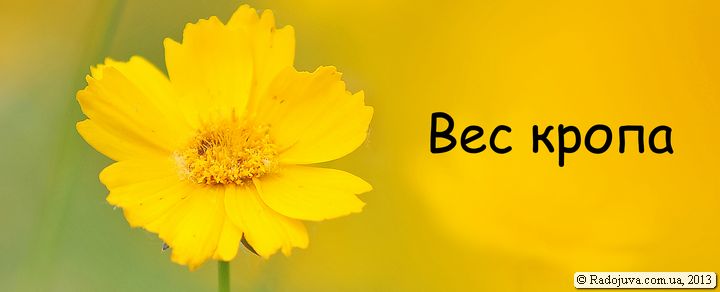This article is written in photographic slang and, moments, filled with my subjective opinions. This article describes the nuances of using cropped cameras and lenses, which few people pay due attention to.

Crop identification
'Crop', 'Crop', 'cropped camera', 'cropped camera', 'cropped sensor', 'cropped sensor' are synonyms for a camera with a reduced light-sensitive element (matrix, film). These concepts are strongly intertwined with the concept crop factor and basic information about crop can be found in the section ' Crop factor '.
Full frame Full Frame, FF, FF, Full sensor size are synonyms for cameras that have an original, not reduced photosensitive element. Nowadays, many amateur photographers believe that FF cameras are a panacea and the peak of the evolutionary development of modern digital cameras. Due to the fact that the price of amateur cropped cameras is several times lower than for full-frame cameras, a lot of amateur photographers use cropped cameras and dream of switching to full frame. Matrix size full-frame cameras is equal to the size of standard 35mm film (film type 135). But full frame is not the limit.
There are medium and large format cameras where the sizes of the photosensitive element are several times larger than the sizes of the photosensitive elements in full-frame cameras. Oddly enough it sounds, but modern full-frame digital cameras are narrow format... It turns out to be a kind of deception - on the one hand, a full frame is something beyond, on the other hand, a full frame is just a narrow format.
Photographers who have been shooting medium or large format all their lives most often look down on today's prohibitively expensive 'Full Frame Cameras' Nikon D4s, Canon 1DX and the like. I am writing this to the fact that there should be a clear understanding that full-frame cameras are just one of the steps in the evolution of camera engineering.

Crop Excellence
Since I use the Nikon system most of all, I will give examples based on Nikon's photographic equipment.
Basically, everyone knows that with the help of a FF camera it is easier to control the depth of field. With a full-frame camera, it is easier to achieve a thin depth of field, blurring the background and background.
But there is a second side to the coin, in which crop surpasses full frame. To get the same angle of view from a full frame lens Nikon AF-S Nikkor 24-70mm 1: 2.8G ED N used on a full-frame camera, on the crop you need to use an analogue - Nikon AF-S Nikkor 17-55mm 1: 2.8G ED IF SWM DX. We assume that 17mm crop and 24mm full frame give approximately same viewing angle and omit the difference 1.5mm EGF (Эequivalent Фsnack Рdistance, 17mm * 1,5-24mm = 1,5mm). But due to different real focal lengths, lenses have different depth of field and different hyperfocal distance... In practice, this has the effect that 17mm is easier to achieve a wide depth of field than 24mm full frame. For example, this is expressed by the fact that when I photograph a group of people in low light (for example, in a temple), the thin depth of field of the 24mm@F/2.8 lens is very strongly felt in the full frame and some of the people who 'fall out' of the field of focus are blurred. I do not need anyone to be blurred in the picture at all. At the same time, if you shoot the same scene with a 17mm@F/2.8 lens on a crop, the field of focus will be larger, this will allow you to capture all people in the field of focus, and when you print such a picture, all participants in the shooting will admire their sharp image. In this case, the lenses use the same aperture, and photographing occurs at the same shutter speed.
Often you can see a recalculation of aperture for cropped lenses. For example f / 2.8 for Nikon AF-S Nikkor 17-55mm 1: 2.8G ED IF SWM DX on cameras Nikon DX will have the equivalent of f / 4.2. You can look at the example of Nikon 14-24 2.8 on photozone.de. This does not mean that such a lens has a real darker aperture (smaller real aperture in terms of T-stops) when used on cropped cameras - this only means that the depth of field for such a lens will be F / 4.2 equivalent to full-frame cameras. Attention: this recount does not affect the exposure, it only affects the recalculation of the depth of field.
Thus, using Nikon AF-S Nikkor 17-55mm 1: 2.8G ED IF SWM DX at 17mm and F / 2.8 we get the equivalent of 25.5mm and F / 4.2. That is, to get the same large depth of field as with a cropped lens Nikon AF-S Nikkor 17-55mm 1: 2.8G ED IF SWM DX, using Nikon AF-S Nikkor 24-70mm 1: 2.8G ED AF-S N we will have to close the aperture to f / 4.2. But in the case of a full-frame lens, this will entail not only an increase in depth of field, but also a decrease exposure. The exposure will have to be compensated either by a longer shutter speed, or a higher ISO sensitivity or a higher flash output.
When you change the aperture by one stop, the depth of field changes in two times. F-stop numbers are F / 1.4, F / 2.0, F / 2.8, F / 4.0, F / 5.6, etc. The difference between f / 2.8 and f / 4.0 is one stop (two times). It turns out that when using a cropped lens, we gain more than twice the depth of field in magnification (F / 2.8 versus F / 4.2). To be precise, the depth of field is 2.25x for Nikon DX cameras. The increase in depth of field is linearly related to the size of the matrix. In fact, Nikon FX and Nikon DX sensors differ in their area by 2.25 times. The number 2.25 is very simple, you just need crop factor (Kf = 1.5) squared: 1.5 * 1.5 = 2.25.
This trick is used in many soap dishes for macro photography. The tiny sensors of digital soap cameras can produce huge DOF with small aperture numbers, which is very important for macro photography. So, to get similar pictures with a simple soap dish and Nikon D3s + Nikon AF Micro Nikkor 105mm 1: 2.8D on a soap dish it will be possible to calmly remove on F / 5.6 from hands with a short shutter speed, and on a large full-frame lens, you will have to close the aperture very strongly to get the same DOF.
Personal experience:
I described the difference in depth of field in detail only because I often shoot various kinds of wide-angle lenses on an open aperture baptism, weddings, etc. I usually use a 28mm lens. On a full frame at 28mm f / 3.5, it is already very noticeable that people 'fall out' from the depth of field. When printing in a format of 20 X 30 and more, it is already quite noticeable that some people are in focus, and some are 'floated'. Sometimes clients complain to me that part of the picture is not sharp. Using a crop camera and a lens with a similar EGF, you can increase the depth of field by a factor of 2.25 while maintaining aperture ratio and simplify this kind of shooting. I understand that you can close the aperture and get a wide depth of field, but in some cases you can’t shoot at F / 11.0, since there is very, very little light for the scene, and using a flash is highly undesirable.
Conclusion:
Equivalent focal lengths when using cropped lenses allow you to get a large depth of field, more objects in the focus area, more satisfied customers. At the same time, we need the same aperture the lens.

Ultimatu crop
After the previous point, the crop has risen to its feet and can now compete with a full frame. But there is one very serious problem when using cropped cameras. And this problem is the lack of lenses. In general, this concerns the absence good professional fast lenses with a comfortable EGF. Professional photographers, such as wedding planners, studio photographers, and storytellers most often use a specific set of lenses with a certain focal length. Usually this is a range of 14-200mm.
But for cropped cameras there are simply no lenses for comfortable shooting. For example, for Nikon DX cameras there is nothing to replace Nikon 14-24 F / 2.8, Nikon 17-35 F / 2.8, Nikon 70-200 F / 2.8, Nikon 80-200 F / 2.8, Nikon 85mm F / 1.4. There is only a replacement for the Nikon 24-70 F / 2.8 in the form of the Nikon 17-55 F / 2.8 DX (and then, there is a Nikon 24-70 F / 2.8 VR, which, again, has no replacement).
Lenses have historically undergone a number of adjustments to suit the needs of photographers when working on narrow 35mm film. We have developed our own optimal standards. For example, reporting in 'close combat' is easier than ever to shoot with the Nikon 17-35 F / 2.8, and for portraits, weddings, use the Nikon 70-200 F / 2.8. These lenses complement each other to provide the photographer's desired coverage of the focal length range, are very easy to use and are a kind of standard. These lenses have undergone a number of modifications, have been hardened by time, and their focal lengths were chosen for a reason.
As a result, for the Nikon DX crop, there is neither a wide aperture-panorama (14-24 F / 2.8), nor a reportage-wide (Nikon 17-35 F / 2.8), nor a portrait-TV (Nikon 70-200 F / 2.8), no fix portraiture (Nikon 85mm F1.4).
In general, for 'professional photography' on a crop, only the Nikon 17-55mm F / 2.8 can be used as a versatile replacement for the full-frame Nikon 24-70mm F / 2.8.
When using lenses from full-frame cameras, the EGF and full-frame lenses largely lose their functionality on crop. To reinforce my words, I will give an example from personal practice. Using a Nikon 70-200 F/2.8 lens on a full-frame camera, I can easily shoot wedding walks and small groups of people at 70mm, all I have to do is step back a little. But when using the same lens on a crop, I have to run back and forth with 70-200mm to shoot witnesses, young people and a few more people. As a result, the 70-200 does not fulfill its function as a normal 70mm lens. For serious photography, crop is a road to nowhere due to the lack of a set of lenses the photographer needs.
There is one more thing - third-party manufacturers have realized the nuance described above and released equivalents. For Nikon 14-24 F / 2.8 there is Tokina 11-16 F / 2.8, for Nikon 70-200 F / 2.8 there is Tokina AF 50-135mm F / 2.8. Nikon 17-35 F / 2.8 replacements were never invented. On the one hand, I often recommend third-party lenses, but I only do this for hobbyists. On the other hand, there is one unwritten rule for professionals to use only 'native' lenses on their cameras. Let me give you an example, so I came to a wedding with 'Tamron', 'Sigma', 'Tokina'. They ask me, what is this lens? I answer - 'Tamron', 'Sigma', 'Tokina'. In response, I only hear “There ... What? ... Sigma? Bokina? " And all my professionalism and trust in me is multiplied by zero. It is difficult to prove to the client that important how to take pictures, and not using any technique. Give everyone only Nikon, Canon, Sony.
Of course, it should be understood that the concepts of 'professional photographer' and 'professional photographic equipment' have very vague boundaries.
We can also mention Canon cameras with APS-H sensor - Canon EOS-1D, 1D MarkII, 1D Mark II N, 1D Mark III, 1D Mark IV, which have crop factor 1.3 and for which neither the native manufacturer nor third-party ones produce lenses taking crop into account. Only full-frame native lenses are suitable for such cameras.
Conclusions:
For full-frame cameras, there are lens solutions with a convenient set of focal lengths. For cropped cameras, there are practically no such lenses.

Crop evolution
In the previous paragraph, I tried to defeat the crop. At this point, I will try to finish it off.
Not only professional lenses have evolved, but also a number of simple 'dark' zooms. Usually, for comfortable, simple photography, the 28mm-XXXmm range is used. For example, 28-50mm, 28-70mm, 28-85mm, 28-100mm, 28-105mm, 28-200mm, 28-300mm. Such lenses are called universal, with their help you can practically shoot anything. Most of their versatility lies in their ability to use the wide 28mm field of view on a full frame camera. The equivalent of 28mm on crop is 18mm, for example 18-55m, 18-70mm, 18-105mm, 18-135mm, 18-200mm, 18-300mm.
For example, Nikon has over 10 class 28-XXX universal autofocus lenses and their modifications. All these lenses are practically unprofitable when used on cropped Nikon DX cameras, as they completely lose their versatility due to the fact that 28mm gives EGF at 42mm (almost fifty dollars). Now the good old lenses, for example, the Nikon 28-105mm F / 3.5-4.5 Macro with outrageous image quality and super fast focusing, are sold for $ 150, since no one needs them.
This is true not only of universal lenses, but of almost all full-frame lenses that have been designed for full-frame cameras. Black magic happens on crop, constantly full-frame lenses with specific goals and objectives'turn into something'. For example, a fifty-kopeck piece in a short-portrait, any shirik into a standard lens, over a shirik into a wide one. The only thing unchanged is the telephoto. Televik and televik on the crop.
The main advantage of crop marketing experts highlight 'free' increase in equivalent focal length. In fact, such an increase is needed only in very rare tasks. For example, I very rarely need a lens longer than 200mm at full frame. Few photographers can really use this advantage for shooting distant subjects. For an ordinary amateur photographer, such an increase EGF often not needed. Many remain deceived by what is usually said about the increase EGF for telephoto lenses. Everything is extremely simple there - the longer the focal length, the better. But due to the fact that the EGF increases not only for telephoto lenses, but for all lenses, from this wide angles suffer greatly. That is, the wide angle of a wide-angle full-frame lens simply disappears when using such a lens on a cropped camera. In general, it is better to shoot wider than narrower - the image can then be cropped, but not vice versa. Because I really like the expression: 'crop eats frame'.
Conclusion:
When using cropped cameras lost the ability to use a huge number of old full-frame lenses with excellent optical and mechanical performance. Often such lenses cost a penny, and their image quality is at a high level.

Crop accuracy
Another important point is accuracy of the focusing system when used on crop and on a full frame of FX lenses. It is connected with hyperfocal distance and a feature of the focusing system of each lens separately.
To shoot the same subject with the same full-frame lens in crop and full frame with the same crop, you need get closer or further to the subject. The difference in shooting distance between the Nikon DX camera and Nikon FX will be 1.5 times. For example, if you need to shoot something with a cropped camera and a full-frame lens from a distance of 6 meters, you will need to shoot something with the same lens and a full-frame camera with the same crop from a distance of 4 meters.
The focusing system is often easier to sharpen the lens at medium focusing distances. This can be related to the step of the focusing ring. When focusing in the infinity region, the focus ring pitch is very small, which may cause more problems with focus accuracy in this range. When using an FX lens on a crop, focusing is shifted toward infinity, which generally degrades the accuracy and smoothness of focusing. This is a very subtle nuance that can not always be traced. It takes a lot of practice to feel the difference.
And also an important point - the shorter the focusing distance, the visually the subject appears sharper (although the depth of field decreases).

Crop weight
It is often said that cropped cameras weigh less than full frame cameras. This is not always true. For example, full frame cameras Nikon D700, D800, Nikon D800E, Nikon D600 weigh less than the cropped Nikon D1, Nikon D1h, Nikon D1x, Nikon D2x, Nikon D2xs, Nikon D2h, Nikon D2hs. Also full frame Nikon D600 weighs about the same as Nikon's cropped ruler D500, D300, D300s, D200, D100. In the general case, the weight of the camera is determined not by the size of the sensor, but by the belonging of the camera to a certain level, for example, professional or amateur. The weight of the camera is very dependent on the materials of which the housing is made. Typically, professional cameras have an all-metal body, unlike amateur cameras that use plastic. So it turns out that professional flagship (with a combo body) cropped cameras of the Nikon D1, D2 series weigh more than an amateur full-frame Nikon D600 or professional Nikon D810, D800, D800E. The weight of the camera can be both a plus and a minus, like everything else in matters of crop.

Crop speed
The implicit advantage of the reduced sensor on cropped cameras is the ability to quickly read the signal from the cells of the matrix and lower power consumption. In fact, this greatly affects the video. So, the first Nikon camera that could shoot video was not Nikon D3s, Nikon D90. Now Nikon D7100, D7200, D5200, D5300, D5500 can shoot Full HD at 60 frames per second, and more expensive cameras Nikon D600, D610, D800,D800E, D4 can squeeze a maximum of only 30 frames per second in Full HD mode. This also affects the photo shooting speed. So cameras with interchangeable lenses Nikon 1 J1, Nikon 1 S1, Nikon 1 V2, Nikon 1 V1, Nikon 1 J2, Nikn 1 J3 and Nikon 1 AW1 can take pictures at a speed of 60 (sixty) photos in one second. It turns out that crumbs Nikon 1 s crop factor 2.7X shoots 5 times faster than Nikon D4s or Canon 1DX. Such speed is possible due to fast reading and signal processing from a 'small' matrix.
Unlike Canon cameras, Nikon full-frame CCMs can operate in DX image mode. This means that any full-frame camera can only use the central part of its sensor, which is completely identical in size to the classic Nikon DX crop. To do this, simply select the DX image area in the camera menu. Thus, using any Nikon FX cameras, you can simultaneously have at hand an analogue of a cropped camera. For example, in Nikon DX mode, the camera Nikon D800 takes 16MP pictures, in size and quality almost the same as when using cropped cameras Nikon D7000 or D5100. True, in Nikon DX mode it is inconvenient to sight through JVI. By the way, some Nikon DX cropped cameras can work in their specific optional cropped mode. These cameras include Nikon D2x и D2xs with an additional crop for high-speed shooting Kf = 2X and Nikon D7100 with the possibility of additional crop Kf = 1.3X.
Of course, crop cameras have been and always will be. But here in the professional segment, cropped cameras no longer have a place... For example, Nikon no longer releases TOP cropped 'combo monsters', the last of which was Nikon D2xsreleased way back in 2006. In 2007, Nikon's line of TOP professional cameras was replaced by a full-frame line, the first of which was Nikon D3. In the future, the entire range of such cameras includes exclusively full-frame models.
The same fate befell the line of cropped TOP cameras Canon with an APS-H sensor. Latest model, Canon 1D Mark IV, was released in 2009, replaced by a full-frame camera in 2012 Canon 1D X.
All the previous ones are just flowers :) (which are on screensavers). For me, as a photographer, full-frame cameras are valued more than cropped cameras due to lower noise at equivalent ISO values. Full-frame cameras have higher ISO values that allow you to take pictures of acceptable quality. If we take cropped and full-frame cameras of the same generation, then full-frame shots will always be more flexible in post-processing, they are much simpler 'draw out'and finalize (especially when shooting in RAW).
Let's take the latest full-frame model among Nikon cameras - D4s, and the latest advanced cropped - D7100, even according to synthetic tests, it is easy to see that the 'working' ISOs of Nikon D4s are 2-3 times higher than those of Nikon D7100 (link dxomark.com). I can say with confidence that no Nikon cropped camera has yet grown in terms of noise at high ISOs even to the very first full-frame Nikon D3. The same situation can be observed with Sony and Pentax cameras. And if you do not take into account Canon EOS-1DS then Canon has exactly the same situation :).
Comments on this post do not require registration. Anyone can leave a comment. Many different photographic equipment can be found on AliExpress.
Global output:
Crop is insidious. Now you know that:
- A full frame can be considered crop from medium format cameras;
- Crop has the advantage of greater depth of field with the same F number and the same viewing angle. This is important for shooting using wide-angle optics;
- For crop there is no line of professional lenses with convenient focal length. In my opinion, this is a very serious drawback of crop;
- Cropped cameras cannot be used properly with a huge number of good old full-frame lenses;
- When using full-frame lenses on crop, the smoothness and convenience of focusing changes;
- Cropped cameras are not always lighter than full frame cameras;
- Full-frame cameras have a significantly lower noise level at high ISO;
- Among professional cameras, there is less and less space for crop.
Extension here.
Material prepared Arkady Shapoval. Training/Consultations | Youtube | Facebook | Instagram | Twitter | Telegram





Gentlemen, please clarify this question for me. It is a fact that Nikon offers little "native" DX lenses. But does not using DX lenses solve the problem? Will the AF-S DX NIKKOR 35MM F / 1.8G and AF-S NIKKOR 35MM F1.4G give different crop results in terms of viewing angle? I understand that these are different (one and a half thousand :-) lenses in terms of optical quality, but 35 mm is 35 mm. Therefore, both 50 mm and 85 mm on the crop feel super-good, naturally, taking into account the 1,5 crop. I agree with Arkady about the area shifting in sharpness, but I think that in most cases this is not critical, because the impeccable quality of the picture compensates for everything. Thanks everyone for the thoughts
Decides. You can get used to it. In my article I wrote about the fact that there is no set of good professional lenses with a convenient focal length. Lenses for full-frame cameras have certain focal lengths due to their ease of use. On the crop, these lenses can be used, but with a loss of convenience. Loss of convenience ultimately reduces the number of good shots and complicates the photographer's work. When you shoot all day long, it feels very strong. For example, for some reason 35tku is recommended as a cropped portrait photographer, but it has strong distortion for a portrait - this is very, very important. FX lenses do work great on DX cameras, but they work very differently due to the shifting focusing distances for the same scenes. In general, I have described the disadvantages of convenience in this article.
simple test. tripod, carcass Nikon D7000 and Nikon D800.
50mm lens. take pictures.
DOF will be the same. the angle of view on the crop will be less. those. crop will not change the depth of field with any place,
it will just crop part of the frame.
the next test, go to Nikon D800 in crop mode. make a frame. It is no different from the Nikon D7000 frame.
and the last test. crop the full Nikop D800 frame in the editor to the size of the crop. The resulting frame is no different from the Nikon D7000 frame.
the result is simple - crop DOES NOT CHANGE DOF!
Why is there porridge and confusion in my heads?
because crop changes the angle of view. and in order to get the same picture as on the full frame, the crop camera needs to be pushed BACK,
those. change DISTANCE. changing the distance certainly changes the depth of field :)
all of the above is true in the framework of identical systems with the same working length.
conclusion.
crop cameras have no optical advantage over crop cameras.
installing a 70-300 lens on a Nikon 7000 crop camera (for example) you will not get a 105-450mm lens. no place.
You will get a 105-450mm lens angle while staying on a 70-300 optics. those. what you get in full frame on the same lens 70-300
just CUTING off some of the information. (!)
+1, I meant the same thing. Especially I do not understand what it means to “recalculate the f-number” - only if the DX lens is not DX, but if you take some “half” or 85k, then F / 1,8 will be on both the crop and FF. Although I figured out the picture with the rays, I will not argue (rather, I will even agree) there will be less depth of field for FF
The aperture ratio will remain the same, but for taking pictures with the same crop on the FX, DX, you will need a different focusing distance, which will affect the depth of field. Therefore, for simplicity, we can talk about recounting not in meters of the focusing distance, but in the feet of the number F.
Sergei, DOF does not change, it is written about it here https://radojuva.com.ua/2011/05/size-of-matrica/, exactly the same as focal. But it is convenient to talk about EGF. Crop changes the ability to control depth of field for the same scenes on FX and DX. I don't see any mess or confusion here except for the one you described here "crop cameras have no advantage over crop from an optical point of view."
in fact, on forums, as a rule, there is an opportunity to edit your remarks. Unfortunately, I don’t find such an option.
I fixed the error a long time ago, you apparently didn’t notice it, see below.,
Sergei
03.06.2013/19/06 at XNUMX:XNUMX Reply
“Crop cameras have no advantage over crop from an optical point of view.”
before the full frame, of course :)
If you carefully read my resource, then Radozhiva is not a forum, but a blog. This radically changes the concept of the site.
this does not change the fact that it is impossible to correct the error / typo in the post.
simplest type options: preview, edit, delete
would be helpful.
their absence creates a situation when an additional post corrects the error but they still do not see it.
not deadly but rather uncomfortable.
There are difficulties with the fact that often a person writes nonsense, then proves it, and then simply edits his comments, trying to hide his traces of the crime. Also, this option will cause a crazy load on the site. In the near future I am not going to invest additional funds in Radozhiva, since it costs far less to feed 20.000 users a day.
Thank you very much !!!!! Finally came - :)))))
"Crop cameras have no optical advantage over crop cameras."
before the full frame, of course :)
Arkady,
even from the comments it can be seen that many have understood that the crop changes the depth of field and that the advantages of the crop over the FF are in the “magic” body magnification by 1.5x.
while the crop does not change the grip, does not change the optical body - in all respects it is worse than the FF. you can always cut (such as recreate a crop) in the editor.
“I don't see any porridge or confusion here, other than the one you described here“ crop cameras have no advantage over crop from an optical point of view. ”
In general, on forums, as a rule, there is an opportunity to edit your remarks. Unfortunately, I don’t find such an option.
I fixed the error a long time ago, you apparently didn’t notice it, see below.
Users, unfortunately, only understand what they are ready for. For increasing the focal length in this article, one tiny paragraph is highlighted, which begins with the words “The main advantage of the crop is marketed by marketers ...”, since many already know about this aspect and I did not want to repeat myself. But other aspects of crop, such as a large depth of field when using equivalent lenses on crop and full frame, the absence of prof. Crop rulers, etc., are generally ignored by users. Most likely this is due to the fact that the majority of users have never "felt" the difference in real conditions, but only heard a lot about it theoretically. In the article I tried to describe my personal experience, which is really important when using this or that aspect of the crop / full frame, but I look at the comments, and it seems that no one has read the article at all. For myself, I extremely sharply highlight the moment that there is practically nothing sensible for a crop for convenient 'professional' shooting. This misunderstanding by users can be explained by the fact that users do not need to shoot for days on the fly and appreciate the possibilities of a good zoom, many can do with 35/50 1.8.
Regarding editing comments - I have not a forum, but a photoblog, the difference is that you do not need to register on Radozhiv (like on a forum).
registered users receive all rights to edit / delete their posts, etc.
non-registered ones should at least have a preview option.
the concept does not change. amenities added to the sea.
There is a wonderful reason to think first, then write :)
yes, especially convenient transliteration :)
Acad! I respect your thoughts very, very much. I read regularly and look forward to new articles. I agree with 99% of what you’ve laid out, but somehow I don’t understand what caused the inconvenience of using FF lenses on the crop for you. Either I'm so incomprehensible, which I have not seen before, or somehow you didn’t intelligibly explain. Do not consider criticism, just thinking out loud.
One of the most popular lenses, for example, for a wedding is the 70-200 2.8, there is no analog for the crop, there is nothing to replace it with for an equivalent focal length and aperture. The same goes for other ranges as well. As I wrote, this is difficult to understand without some practice under your belt.
Tokina AT-X 535 PRO DX AF 50-135 mm f / 2.8
Only, of course, not a native lens. Yes, now the customer is most likely not asking for the brand of the lens, but the crop is not a crop. Although I will not judge what I do not know about.
I described for this lens, but for example, where is the stabilizer in it? There is also Sigma 50-150 2.8 and much more - but all this in no way replaces prof. 70-200.
Oddly enough, there are no professional lenses for crop. After all, the first electronic DSLRs were crop when they could not make large sensors. And to our time, the cropped professional camera d300s has survived. Although yes, still the story of 35 mm is much larger than the crop.
Maybe in 5 years FF will become even more accessible and crop will disappear as a class? What do you think?
For example, on May 17, 2000, Canon had 30d of the first mirrors, then 1D with K = 1.3x, then 60d, and already in 2002 the full-size Canon 1DS came out. So it took about a year and a half from the appearance of the cropped SLR to the full-format one.
It looks like canon hasty nikon.
The first D1 camera in 1999 with a crop factor of 1.5 and only in 2007 the full-format D3 came out. Still, 8 years is not a small period either. Although what is there to go deeper into history ...
How's canon doing it? The same trouble with the lenses?
Given that Canon has a crop of 1.6X, the symptoms or merits of the symptoms only increase. Nikon c FF really tightened.
for dx cameras, professional optics cannot be a priori! dx cameras are cheap, and the segment is not professional, and is designed for the mass buyer! but in general I’ll tell you so, the concept of a professional is someone who can skillfully master any equipment! I am a turner by profession, but this does not prevent me from working on milling and grinding ! the same in the photo, you just need to competently own the equipment that is in the hands at the moment! I think you will agree with me!
for finances, I can’t afford ff, but I changed the optics to full-frame, assembled the sigma ex line, and the Nikon d7000 camera, I’m working with it for now!
Hello everyone, guys, why swear, someone wrote the FF correctly, if only because you can make a crop out of it without expenses, you can’t get a FF crop out of it, learned from an article that you need to change your goal from D300 to D700, you can shoot on any camera in crop mode, you can’t turn on the camera in crop camera, and you can buy lenses with convenient focal lengths for ff realistically several times cheaper, if you also turn to Tokina the same, old full-frame screwdriver lenses are a penny, the quality of Pts is good, for crop for these de You can’t find an analogue :( (I mean an analogue taking into account the crop factor)
On the D700 in crop mode, the working area of the matrix will be about 5.4 Mp - not enough.
right. therefore the D800 is convenient - 15MP crop. :)
We’ll buy a Ferrari and harness it with horses because there’s no gas left :)
apparently covering the frame with AF points does not mean anything to you :)
Neighing :) like a horse
FF is good for everyone except the price.
About the small depth of field - I think, not very correct.
On FF, you can easily raise the ISO and close the hole. On crop, let the depth of field suit you, but shooting above ISO800 is already problematic.
Full-size cameras also have ISO restrictions.
As for the focus points, I honestly never understood this, I always focus on my D200 at the center point, I no longer need to focus and move the framing camera a little to the side, but I always know where the focus is, as soon as you trust the automation, I’m sure to focus not where I wanted, further along the working area of the crop on the D700, 5.4 MP is enough above the roof for the tasks that I set for myself, I do not make advertising photos for billboards
+1
And yet, guys, what does FF do not like lenses on the crop camera, Arkady correctly said, if you want to make the same picture at 50 mm on the crop, it will be almost infinity at fifty dollars and therefore getting the focus is much more difficult than if you did it on FF, where much smaller distances are used for the same picture
On photosites, I often see growth portraits shot at 85. It seems to me that this is equivalent to the same portrait shot with a crop at 50mm. I wonder if they have problems with focusing? I think that 85 will also focus closer to infinity.
not equivalent. you confuse the change in focal with the change in the angle of view of the lens.
on the FF crop, fifty dollars is still fifty dollars. just with cropping along the frame.
and who prevents to change the lens with another FR when shooting an object?
The question is not only to Arkady.
Do you agree, dear ones, that the picture on the 35 mm lens on the crop and the half speed on the FF are a little bit, or maybe a little bit, different weight?
Or is it another myth?
a lot, different things!
Now I really want to see a review article about successful lenses specifically for crop. And then each subsequent review of the lens seems to hint that there are a lot of good glasses, but not for me)
Yuri! I’m not a master at writing articles, but I’ll tell you so!
my line of sigma ex trunks: (10-20 \ 3.5 dx) (24-70 \ 2.8 FF) (70-200 \ 2.8 FF) (50 \ 1.4 FF) (MACRO 105 \ 2.8 FF) (150-500 \ 3.5- 5.6 FF) (and one Nikkor macro 40 \ 2.8 dx)
2 Nikon D7000 cameras
You can share your experience of how sigma 50 f1.4 works on the D7000.
I am considering the option of buying this lens for portrait and scene shooting
Crop Digital Photography started. And now for me, a teapot, holding a DSLR and taking pictures with it is cooler than using the so familiar soap dish both in sensations and in results (not always, but often). I think the crop will take root. And the lenses will take root, because all the same, non-pros will want to try prof. lenses without changing the camera. Marketers have already begun to understand this (judging by the article). I am not a member of social networks and cannot support the project. Why doesn't the author make a semblance of a social network out of the site for those interested in photos? There will be demand, for poets there is. For example, "poems" ru.
Many wedding photographers use the D300 in conjunction with 24-70.
I wonder why it is 24-70, and not nikkor 17-55 / f2.8, tokina 16-50 / f2.8 or, at worst, tamron 17-50 f / 2.8. After all, they are increasingly suitable for crop, because they just give angles equivalent to full-frame 26-83.
Why is it 24-70 on the crop, everything is simple.
One of the favorite focal ranges for weddings with FX cameras is (subjectively) a range of 70 to 100 mm (and higher for portraits). This FR range provides the best zoom lens of 70-200mm 2,8. He is their favorite. But on the crop it will not be very convenient, since the focal lengths are shifted 1.5 times, that is, from 105mm. This is already a bit too much. But 24-70mm becomes very convenient - 36-105mm. The same 70-100, plus the missing 36mm.
It is a pity that there is no such lens on the FX. In conjunction with 14-24 F / 2.8 or 17-35 F / 2.8 would be a chic option at a banquet.
Sometimes 70mm, when using 24-70 on the FX, is not enough, you often have to throw glass, or carry 2 carcasses on yourself. And 2 carcasses have already strained for the whole day.
but at 24 on a crop you often have to crawl along the walls, and where then is the much-praised versatility of 24-70?
Here you go…. I just bought myself a nicon D7100. After D3100 I can't get enough of it. I thought that more is not needed for the next 5-10 years. And now the thought of FF will eat up me on the sly. It's good that the thought of a new car eats up more. )))))))
And I love compote!
I believe that everyone should choose ff or chrome based only on their thoughts, needs and conditions.
After purchasing the D5200 and analyzing the range of crop optics, I came to the described conclusion - there is no good optics for cropping. Now I read about it here and completely fell into sadness. Even if you take a collective petition to Nikon, write ... I wonder if Nikon plans to release good optics for crop? And then the cheapest D600 is about 60 thousand rubles. the new one is worth, which is quite a lot ...
Do other manufacturers of DSLRs have the same problem?
When comparing lenses for crop and full frame, one more important point should be taken into account.
For example: Nikon AF-S Nikkor 24-70mm 1: 2.8G ED AF-S N / full frame /
and “analog” for Nikon AF-S Nikkor 17-55mm 1: 2.8G ED IF SWM DX crop
At the focal length of 55 mm of lens No. 2, yes, we get a viewing angle similar to the focal length of 70 mm of lens No. 1.
Now, pay attention!
And the scale of the image from the lens # 1 will still be larger! The object will be "closer"! Which, in principle, is what the photographer is trying to achieve when zooming. Therefore lens # 2 will NEVER match the capabilities of lens # 1. and they are not analogues!
Here's an even sadder picture for the crop ...
The prospect will be more squeezed.
Thank ! Very useful article !!!
Of course PERSPECTIVE !!! This is the fundamental difference between the picture for different sized matrices. I personally do not understand the magic of light sensitivity at all. The use of high ICOs is known to be limited by noise. Suppose that by filming a plot on ICO_3200 on FF, we get a clean picture, practically without noise. Now we cover a part of the matrix area at the edges (let's say with an opaque plate with a rectangular cutout in the middle; - that is, we create a “crop.” Shoot at 3200 with the same exposure and everything is fine, without noise .... Bold pixel? Is this all explainable? On Nikon Nikon D800 pixel in terms of "fatness" is almost one to one, but in noise at high heaven and earth, although in the crop mode D7000 allows you to shoot with low noise at high sensitivity ... Arkady! ...
The perspective is taken from different focal points for different matrices. As for the d800 / d7000 and the like, I have been thinking for a long time, but so far I have no sensible explanation.
And now we recall the article that Arkady refers to in almost every review - “How to photograph is important, not what”
Dmitry, +1.
There is a familiar "temkhnoman" in photographic equipment, describes some of the advantages of ff, a bunch of disadvantages of crop. After communicating with whom it seems that the crop is generally useless and photography is possible only on ff. This is, of course, his opinion (everyone has his own), but the main thing in photography is the photography itself and, possibly, for some photographers the process itself.
Once I witnessed the following episode from my life: A wedding, a friend took photos on a simple soap dish from Sony, a photographer on Canon (ff by the way). Bottom line: disappointed spouses and shocked me - photographs on a soap dish are many times better and more interesting (from an aesthetic point of view) than on the “prof.” photographer.
He wrote all this as life examples for the article and the phrase Arkady: “It is important how to photograph, and not what.”
PS A crop / no crop - who has what capabilities and abilities.
Good day!
The first time I write on this blog (and indeed the first time in general on blogs). The article is wonderful, but one moment remained incomprehensible
On the crop camera, let's say d7000, Nikon 50mm f / 1.8G is installed. Due to the crop factor, 50 mm will become 75 mm and F will become 2,7,
and what happens if you install, for example, any Nikon 35mm f / 1.8G AF-S DX DX lens (for example), it’s clear that 35 will become 52,5, but what will happen to the aperture? Will it also change to 2,7 or will it remain 1,8? Maybe I overlooked something, but I did not understand it.
And the question number two is that if the FF camera, say d700, set the DX mode and put on the same Nikon 35mm f / 1.8G AF-S DX, will the F change? or just trimmed edges to 52mm?
for a Nikon 50mm 1: 1.8G AF-S Nikkor lens when used on a Nikon DX D7000 (APS-C, Kf = 1.5x) camera, its EFR (not FR) will be 75mm, and the equivalent aperture in terms of depth of field will be F / 2.7. In fact, in the EXIF data module on any camera, you will see exactly the values that are written on the lens - namely 50mm and f / 1.8.
If Nikon 700mm 35: 1G AF-S Nikkor is installed on the Nikon D1.8, then it will be a regular 35mm lens with aperture f / 1.8, which will just give black corners. There are links from this article to the adjacent one more than once about information about the crop - https://radojuva.com.ua/2011/05/size-of-matrica/ и https://radojuva.com.ua/2012/03/nikon-lenses/.
Thank you for such a prompt reply, about the FR I had an unfortunate typo.
Thanks again, now it’s more clear.
Hello. The article is just fine, but I think that: crop cameras shoot video with stereo sound (at the moment, full-format ones - no), the frame rate is higher (it is said here), they are cheaper (significantly), and the photo quality is the same ( can only be distinguished by a professional). I “put on” it 18-200 or 18-140, bought a couple of fixes (to indulge) and that's it, for an amateur above the roof and all this for the price of only a full-frame carcass! Maybe I am thinking as an amateur, but such "users" as I am the majority.
I forgot to add that most of the old lenses are not suitable for video - the screwdriver makes a lot of noise. And the modern CZK is not only a PHOTO device for a long time. Therefore, the fact that they do not fit on crops is not a big deal.
Typically, videos in the ZK are shot with manual focus.
And the thought is wonderful. And with such lenses, you can manually change the aperture. Also manually. Need to try. Thank you, Arkady. This is the best photo site. You know how a restaurant where the chef loves to eat. Everyone is pounding there. The attitude to business is intuitive. You are tasteful, thank you.